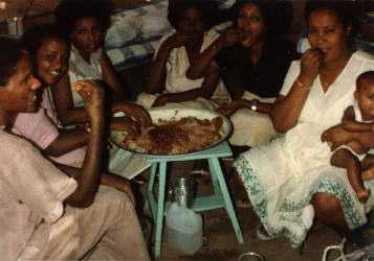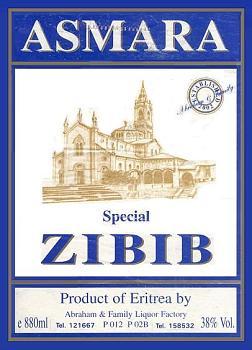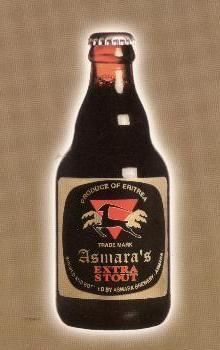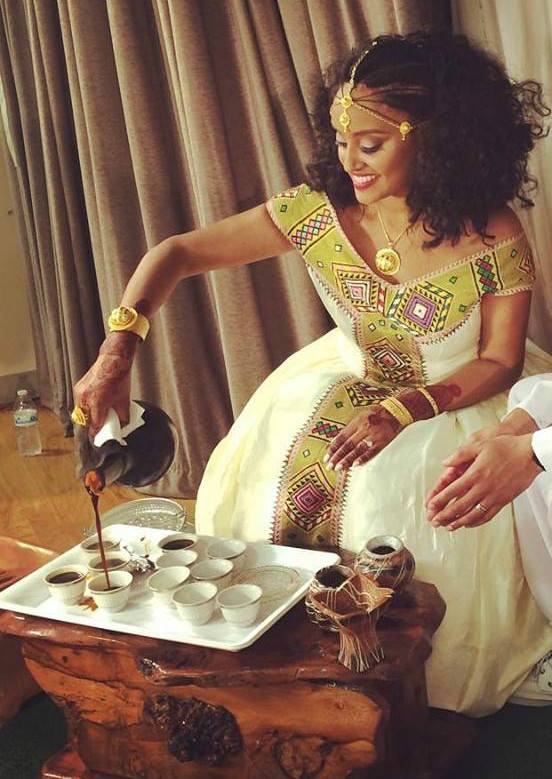Map of Eritrea
Location and geography
Eritrean history
Border conflict with Ethiopia
Political structure
Eritrean anthem
Economy & currency
Climate
People
Languages
Religion
Health care
Transport
Cuisine
News, links, books and more
Asmara (Asmera)
Agordat (Akordat)
Assab (Asseb)
Barentu
Dahlak islands
Dekemhare (Decemhare)
Ghinda (Ginda)
Keren (Cheren)
Massawa (Massauwa)
Mendefera (Adi Ugri)
Nakfa (Nacfa)
Semenawi Bahri (Filfil)
Tessenei
(Teseney)
Eritrean Cuisine
Parts of Eritrea are very fertile and produce good crops of cereals, peanuts vegetables and fruit. The selection of vegetables and fruits available on the markets is seasonal.
Eritrean farmers raise goats, cattle, sheep, pigs and chickens for the local and Asmara markets. The animals are slaughtered at the meat slaughtering plant. They have been inoculated and have undergone careful inspection.
Fish consumption is rather low in Eritrea, as Eritreans are traditionally meat-eaters. The Red Sea is home to more than 1,000 species of fish, including tuna, red snapper, kingfish, sardines and other prime food fish. There are also large stocks of high-value species, such as lobster, crab, oyster, and shrimp.
Most meals are eaten at a low table, shared from a large plate with fellow diners, with the hands. Before eating, one of the women of the household will bring a basin of water where to wash the hands.
People eat (in Tigrinya: bla) together, sharing the food
The two staples are kitcha, which is a very thin, baked unleavened wheat bread or pancake and injera, a spongy pancake made from taff, wheat and/or barley, maize or sorghum. The grains are ground up, made into a watery dough and then left to ferment for a couple of days before being fried or baked.
Injera is eaten with stew, usually called zigni, made from whatever is available (meat or fish, vegetables or a combination of the two). It is simmered for hours, in a tomato sauce spiced with berbere, chili powder and other spices. Tsebhi is a meat sauté prepared with lamb or beef, fresh tomatoes and hot peppers.
Some Eritreans cannot afford a meat-based diet and they eat shiro a chickpea porridge made in many different ways with the injera. Alicha Birsen is a lentil curry.
When it is served several injera are usually put on a tray and the stew poured into the middle. You break of bits of injera and scoop up the stew. People eat together, sharing the food.
Your host will be delighted when you show your appreciation with the word tu’um (delicious). Eat with your right hand only and don’t touch your lips with your fingers or lick your fingers.
A delicious tray of injera and relishes.
Once an Italian colony, Italian dishes are also very popular in Eritrea. Most restaurants serve lasagna, spaghetti and other pasta's. There are various Pizza restaurants in Asmara.
The national beverages are called suwa, a beer-like alcoholic drink brewed from sorghum, mies, a fermented honey drink, and Araki, a locally made anise-flavored liquor similar to Ouzo. Espresso and tea (ask for shahi), always served with a lot of sugar, are very popular. Blended banana, mango, or papaya juices are also very common in the major cities.
"Araki", an aniseed flavored liquor Abraham & Family Liquor Factory
Asmara - EritreaAsmara Extra Stout beer Asmara Brewery
Asmara - Eritrea
Coffee ceremony
Taff
Taff is one of the smallest grains in the world, measuring only about 1/32 of an inch in diameter. Approximately 150 grains equal the size of a kernel of wheat. teff is considered to have an excellent amino acid composition and lysine levels. One cup of cooked teff contains 387 milligrams of calcium (40 percent of the USRDA, which is more than milk), 15 milligrams of iron (100 percent of the USRDA and twice as much iron as wheat and barley). teff is high in protein as well as fiber. A rich source of boron, copper, phosphorus, zinc.
Taff is ground into flour, fermented and made into injera. teff is also eaten as porridge or used as an ingredient of home-brewed alcoholic drinks.
Coffee is something of a delicacy and to be asked to take coffee is a special invitation, a symbol of hospitality, to honor a guest. The Eritrean coffee, 'bun', pronounced as 'boon' is always made by a woman, who washes the green beans and roasts them in a pan called a 'menkeshkesh'. When the beans are dark enough, the pan with the smoking beans is passed around and one fans the smoke so as to appreciate the aroma of the freshly roasted beans. The beans are ground and put on a small rush mat (mishrafat) which is used as a funnel to pour the coffee into its pot (jebena). Water is added and the coffee brought to the boil over a charcoal brazier. It is shameful to let the coffee boil over. The hostess sets the mood by burning incense. When all is ready sugar is put in the small cups (finjal) and the coffee is strained into them. Popcorn is eaten at the same time.
If you have accepted an invitation for coffee be prepared to wait an hour for it to be completed. It is rude to leave early. Standard practice is that you must have three cups and compliment the taste ('tu um'= delicious), after which you are able to leave whenever you wish. The first round of the Eritrean coffee ceremony is called 'awol'. The second and third round 'kale eyti' and 'bereka', and the fourth round is of the coffee ceremony is called 'derdja'.
The Eritrean coffee ceremony.© Hidmona Production.



